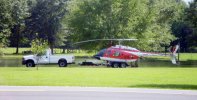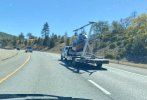I’m sure they won’t regret this decision at all.A
Any thoughts on this article about restructuring the Army Apache fleet?
U.S. Army Plans Major AH-64E Shift Amid Transformation
U.S. Army Plans Major AH-64E Shift Amid Transformation | Aviation Week Network
The U.S. Army will further realign its attack helicopter fleet by shifting a large amount of its advanced AH-64E fleet to the National Guard.aviationweek.com
-
Please take a moment and update your account profile. If you have an updated account profile with basic information on why you are on Air Warriors it will help other people respond to your posts. How do you update your profile you ask?
Go here:
Edit Account Details and Profile
You are using an out of date browser. It may not display this or other websites correctly.
You should upgrade or use an alternative browser.
You should upgrade or use an alternative browser.
Hot new helicopter/rotorcraft news
- Thread starter Randy Daytona
- Start date
What's the current mindset / dogma with regard to use of attack helicopters? Direct action vs close air support vs anti armor?I’m sure they won’t regret this decision at all.
Yeah it’s BS because of the power of certain state leaders. It makes absolutely no useful sense.
Nothing new though as Carolina got V6s before almost all of the Active fleet. And these are the last people you want being the Corps deep asset.
Do you mind expanding on that? I am quite curious.
What's the current mindset / dogma with regard to use of attack helicopters? Direct action vs close air support vs anti armor?
Hard to tell right now. You’re probably definitely going to see more of a shift to multi-role attack/utility variants across the board. Attack variants have shown significant value when used in a combined arms setting, but this all maybe more of a shift due to Army doctrine than anything else. The Army tends to use attack helicopters in more a “deep” strike role than the Marines - operating deep inside enemy lines presents risks with limited investment in ASE. Drones and loitering munitions reduce that risk for commanders, so not overly surprising.
I’m just not up to speed on how fast they’re going to move these capabilities into all formations. We’re still trying to figure it out ourselves - and we’ve been working at it for 4-5 years now. Ukraine offers a lot of insight, but they also don’t have the same joint multi-domain capabilities or training we do - so it tends to shape their tactical aviation employment in different ways.
Amongst the Guard Apache units there is a favored son.Do you mind expanding on that? I am quite curious.
Similarly you have the Mississippi guard which has 1 company of the 3 that actually fall under Texas. They are the most abused child of the group. They weren’t scheduled to come out of Deltas like on the chart until ATI and the maintenance evaluation at Rucker caused us to chose to shut the fleet down (per fly hour costs were getting insane and parts availability was gone)
It’s no coincidence who sits in the senior South Carolina senate seat and the fact that the fielding structure for EV6 was changed and after original publication of the Xord. We still have right now, Delta model pure Active Duty Cabs, and meanwhile guard units were given transition from D direct to EV6 over those units when the original plan was the Guard would fly the delta to maintain a single maintained structure amongst the ECABs (not that guard Apaches deploy what that’s worth). There have been no EV6s in the entirety III Corps which is constantly demanding to know why we don’t have Spike, and while there are a host of points on that the fact we didn’t have any V6s was a big non starter to tell the Corps commander (who was just as upset about it when he was the Div commander).
Last edited:
1. This has far more to do with maintaining and sustaining than any other single factor in the decision. The cost to blade hour on Ds was exceeding the 47 cost per blade hour and riding. Training and flight hours secondary to that, we can’t pay to fly a force as fat as it is. Not without starving everybody into minimums only so we have to get smaller to field a fully trained organization. This also helps our headquarters staff problem out since we now won’t be sitting at 40-60% with a lot of skill positions going unfilled or using that time to do other people’s work.What's the current mindset / dogma with regard to use of attack helicopters? Direct action vs close air support vs anti armor?
2. The democratization of airspace users and group 1-3 UAS density makes it a much different airspace construct to exist in over the brigade combat teams.
3. We aren’t losing Apache units so much as going back to what we had in the first place. The Cavalry squadrons were never supposed to be a second party of attack aircraft pretending to do recon and no Division/Corps maneuver commander intended to use them that way so the point was moot. What this is focusing is an attempt to force the targeting cell to not simply treat the Apache as its easy button in shaping what artillery can’t reach. We’re also putting a massive investment in moving Rockets down from Corps so that is a big factor.
Can you explain a “blade hour”? Same as a flight hour, or do you track transmission time? Just have never heard that term.1. This has far more to do with maintaining and sustaining than any other single factor in the decision. The cost to blade hour on Ds was exceeding the 47 cost per blade hour and riding. Training and flight hours secondary to that, we can’t pay to fly a force as fat as it is. Not without starving everybody into minimums only so we have to get smaller to field a fully trained organization. This also helps our headquarters staff problem out since we now won’t be sitting at 40-60% with a lot of skill positions going unfilled or using that time to do other people’s work.
2. The democratization of airspace users and group 1-3 UAS density makes it a much different airspace construct to exist in over the brigade combat teams.
3. We aren’t losing Apache units so much as going back to what we had in the first place. The Cavalry squadrons were never supposed to be a second party of attack aircraft pretending to do recon and no Division/Corps maneuver commander intended to use them that way so the point was moot. What this is focusing is an attempt to force the targeting cell to not simply treat the Apache as its easy button in shaping what artillery can’t reach. We’re also putting a massive investment in moving Rockets down from Corps so that is a big factor.
"A blade hour is one hour of operation with the helicopter’s rotor system turning under engine power. It’s distinct from purely engine or flight hours and is often used as a basis for maintenance scheduling, component life tracking, and operational cost calculations." (Credit ChatGPT)Can you explain a “blade hour”? Same as a flight hour, or do you track transmission time? Just have never heard that term.
"Define the term 'blade hour' in context of Army Aviation"
This."A blade hour is one hour of operation with the helicopter’s rotor system turning under engine power. It’s distinct from purely engine or flight hours and is often used as a basis for maintenance scheduling, component life tracking, and operational cost calculations." (Credit ChatGPT)
"Define the term 'blade hour' in context of Army Aviation"
Essentially it’s the per hour cost of all the things that go into a viable hour of training.
The D model was almost triple what an E model was cost depending on how it was calculated, and there were some real fleet changing adaptations that were making it worse because they use actual different rotor blades the D model drive train was never made for. So as we ran out of D model steel blades and flew approved composite blades from the E model fleet…. Well there was additional time before overhaul costs that jumped the price of flying the airframe.
A lot of the D model readiness rate over the last half decade was really a lie, because all the units that converted divested their on hand bench stock so units just inhereted this massive excess pile of unique spare and consumable parts…. Until it was all consumed. That was last year, and the “get rid of all the D’s” COA was one of the options… I’m surprised they picked it and I’m laughing at the people that designed the force transition model who all said it would never happen, but here we are.
Essentially it’s the per hour cost of all the things that go into a viable hour of training.
How new is this? A HUMs like system is relatively new to the Navy (really only becoming wide spread with the Sierra and Romeo) and otherwise the only real metric that could be measured was the hour meter on the ECUs.
Like hscs, I hadn't heard the term before, but it was always something I found amusing that no one was tracking because of how much time we spin on deck in the Navy without logging any time.
Agreed. I think that HUMS takes care of much of it, and it’s easier to standardize NAE metrics to flight hours.How new is this? A HUMs like system is relatively new to the Navy (really only becoming wide spread with the Sierra and Romeo) and otherwise the only real metric that could be measured was the hour meter on the ECUs.
Like hscs, I hadn't heard the term before, but it was always something I found amusing that no one was tracking because of how much time we spin on deck in the Navy without logging any time.
Pretty long time as far as I know.How new is this? A HUMs like system is relatively new to the Navy (really only becoming wide spread with the Sierra and Romeo) and otherwise the only real metric that could be measured was the hour meter on the ECUs.
Like hscs, I hadn't heard the term before, but it was always something I found amusing that no one was tracking because of how much time we spin on deck in the Navy without logging any time.
It’s how we forecast the cost of the flying hour budget to corps.
You can see them daily on I-10 headed to Whiting - aka, “The Truck of Shame” after an overtorque (or maintenance)View attachment 43626
Anyone buy a helicopter recently? I didn’t realize how easy they are to transport. Spotted on I-5 South in Northern California.


